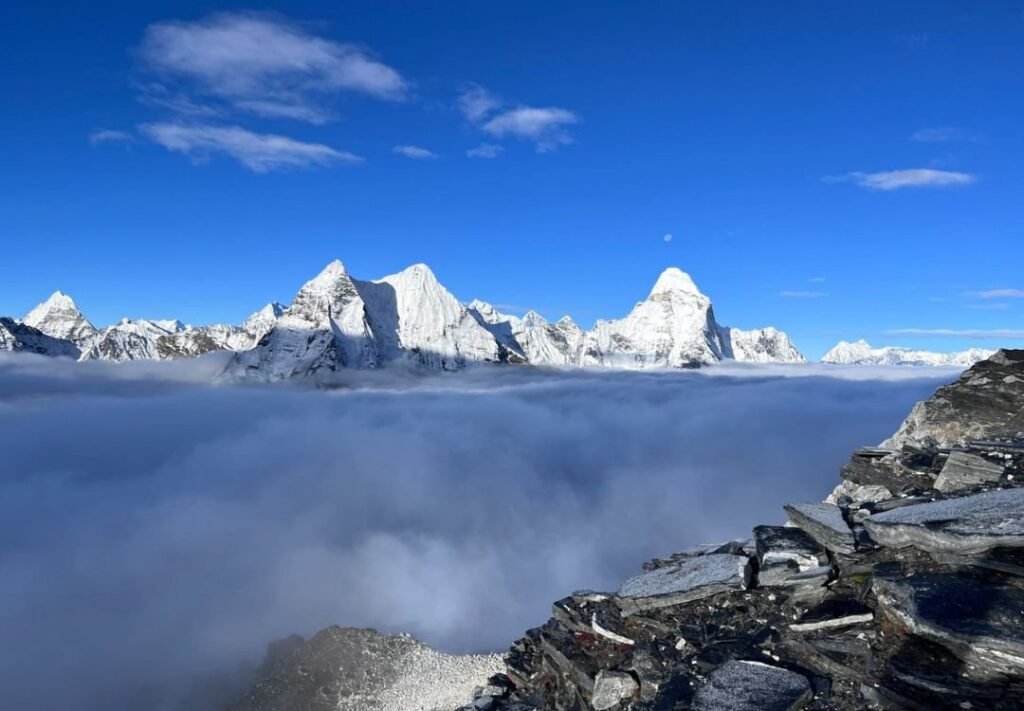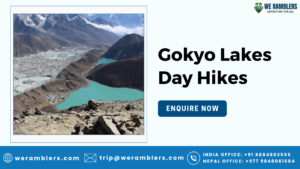Insurance for Island Peak Climb: Why It’s Essential for Your 6000m+ Himalayan Expedition
The Island Peak Climb, also known as Imja Tse, is one of the most sought-after 6000-meter-plus summits in Nepal’s Khumbu region. Towering at an altitude of 6,189 meters (20,305 feet), this glaciated peak stands as a rite of passage for trekkers aspiring to transition into high-altitude mountaineering.
The route blends challenging ascents with iconic Himalayan landscapes. Trekkers typically follow the Everest Base Camp trail for acclimatization, passing through landmarks like Namche Bazaar, Dingboche, and Chhukung, before reaching Island Peak Base Camp. The final push involves glacier crossings, crevasse navigation, and steep rope-assisted climbs, making it a truly technical endeavor.
Though classified as a “trekking peak,” the climb demands more than standard trekking fitness. With its altitude, terrain, and unpredictable weather, Island Peak poses serious risks. Its popularity among international trekkers highlights the need for meticulous preparation, especially when it comes to securing specialized insurance for Island Peak trek that covers 6000-meter-plus climbs.
Why Do You Need Insurance for Island Peak Climb?
Unlike low-altitude hikes or general tourism, the Island Peak expedition pushes your body and your risk exposure to the extreme. At elevations above 6,000 meters, the dangers are heightened, and the consequences of unpreparedness can be severe. Standard travel insurance policies are almost always inadequate for climbs involving alpine equipment, glacier travel, or high elevations.
High-altitude expeditions like Island Peak require insurance that is specifically designed for trekking above 6000m, and that includes critical components like emergency helicopter evacuation, hospitalization, and mountaineering activity inclusion. Without this, a single medical incident can spiral into a financial and logistical nightmare.
Choosing insurance for Island Peak Climb means opting for a provider that understands the unique hazards of remote, technical climbs. It’s not just about protection; it’s about peace of mind and access to vital services when things go wrong at 6,000+ meters.
High Altitude Risks: Why Insurance Over 6000m Is Critical
Trekking at or above 6,000 meters significantly increases the chances of encountering altitude-related illnesses such as Acute Mountain Sickness (AMS), High Altitude Pulmonary Edema (HAPE), and High Altitude Cerebral Edema (HACE). These are not minor discomforts; they are serious medical emergencies that require immediate descent, and often, aerial evacuation.
At such elevations, the human body struggles to adapt, even with acclimatization. Symptoms can escalate quickly, and self-recovery is not always possible. Emergency helicopter rescue is the only viable evacuation method from high camps near the Island Peak summit.
Your policy must cover altitudes above 6000m, and clearly state inclusion of emergency airlift services. This is non-negotiable. Without coverage, securing a helicopter could involve complex logistics and unaffordable upfront payments. The nature of the terrain, combined with extreme conditions, makes trekking insurance over 6000m a critical component of any summit plan.
Accidents and Injuries on Technical Terrain
Island Peak is not a simple trail walk; it is a mountaineering expedition. Climbers must navigate fixed ropes, use ice axes and crampons, cross glaciers, and deal with exposed ridgelines. These factors introduce a real risk of accidents such as falls, rope-related injuries, and cold-weather trauma like frostbite.
On steep snow slopes and icy sections, even a minor mistake can result in injury. Moreover, high altitude often compounds the severity and impact of otherwise manageable wounds. General travel insurance policies typically exclude coverage for technical climbing, especially when equipment is used.
To stay protected, your Island Peak Trek Insurance must include:
- Technical climbing and mountaineering inclusion
- Glacier and rope-assisted ascent coverage
- Emergency evacuation following injury
- Medical assistance for trauma and fractures
When climbing above 6000m, accidents are not only more likely, they are also more complex and harder to manage. Your insurance must match the level of your climb.
Illnesses During the Island Peak Climb
Long before the actual summit, the trek to Island Peak’s base camp itself exposes you to fatigue, exposure, dietary shifts, and limited sanitation. Illnesses such as gastrointestinal infections, altitude-related fatigue, flu, and respiratory problems are common among trekkers in this region.
Remote settlements like Dingboche or Chhukung have minimal healthcare infrastructure. If symptoms escalate beyond what a basic first-aid kit can manage, the only option is rapid descent or air evacuation to Kathmandu. Time becomes a critical factor, and your ability to access emergency medical care hinges on whether your insurance provider covers such interventions.
Good travel insurance for Island Peak should include:
- Medical treatment during trekking
- Evacuation even in non-trauma situations
- Provisions for hospitalization in urban centers
- Repatriation if necessary
In 6000-meter-plus environments, even minor health issues can become expedition-ending events. With proper insurance, they don’t have to become financially catastrophic as well.

Flight Disruptions and Baggage Loss: Importance of Insurance for Island Peak Climb
The journey to Island Peak starts with a flight to Lukla Airport, which is frequently delayed or canceled due to volatile Himalayan weather. These disruptions can significantly impact your itinerary, causing missed connections, rescheduled accommodation, or extra days in Kathmandu.
Additionally, if your gear, especially technical equipment like mountaineering boots, harnesses, or down suits, is lost or delayed, it could compromise your climb altogether. Replacing specialized items in Nepal is often difficult, time-consuming, and expensive.
Your Island Peak Climb Insurance should account for:
- Trip delay and interruption support
- Flight cancellation and rescheduling assistance
- Coverage for lost, stolen, or delayed gear
- Compensation for essential equipment replacement
High-altitude expeditions offer little room for logistical errors. Coverage for flight and gear-related issues helps you stay on track, even when things don’t go as planned.
What Your Trekking Insurance Must Cover
When purchasing insurance for Island Peak Climb, make sure your policy includes the following essentials:
- Helicopter evacuation from elevations above 5,000m
- Medical coverage for high-altitude illnesses and injuries
- Inclusion of technical mountaineering activities
- Coverage beyond 6,000 meters elevation
- Trip cancellation/interruption due to illness or weather
- Lost/delayed baggage and equipment protection
- Optional: COVID-19 and infectious disease provisions
These components form the foundation of a solid high-altitude trekking insurance plan. Policies that cap at 5,000m or exclude technical climbs are inadequate for this expedition. Be sure to review the fine print and consult with your insurer or trekking company before finalizing coverage.
Recommended Insurance Providers for Island Peak
Not all insurance companies are prepared to support 6000-meter-plus expeditions. Below are some providers known for offering specialized coverage for Island Peak and similar technical climbs:
- Global Rescue – Offers high-altitude evacuation and has no altitude limit
- World Nomads – Covers adventure sports and trekking over 6,000m with upgrades
- IMG Global – Offers plans for mountaineering and trekking with altitude extensions
- Alpenverein (Austrian Alpine Club) – Includes mountain rescue, medical, and legal aid for climbs up to 7,000m
- Adventure Care / True Traveller – Provides strong coverage for European climbers on technical expeditions
- Seven Corners, AIG Travel Guard, ASC360 – Offer customizable plans for high-risk travel and mountain climbing
Always verify that the selected plan covers mountaineering, use of technical gear, and evacuation above 6000 meters. Some policies may require additional add-ons to activate these features.
Typical Insurance Cost for Island Peak Climb
Insurance pricing for high-altitude trekking varies significantly depending on nationality, coverage limits, duration, and specific policy features. However, instead of focusing on price alone, assess whether the policy includes:
- Coverage for 6,000 meters and above
- Technical mountaineering inclusion
- Helicopter evacuation and medical transport
- Protection against trip delays or interruptions
While low-cost plans may seem attractive, they often exclude the very features needed for an expedition of this nature. Prioritize comprehensive protection that aligns with the serious risks involved in a 6000-meter-plus climb like Island Peak.
Tips for Choosing the Right Insurance
Here are key things to check before finalizing your Island Peak insurance:
- Confirm altitude coverage above 6000m
- Check for mountaineering and technical gear usage inclusion
- Read the policy exclusions and limitations carefully
- Disclose pre-existing conditions to avoid claim denial
- Purchase the policy before leaving your home country
- Carry digital and printed copies of your insurance on the trek
Some operators and helicopter services may also require direct communication with your insurer for faster response, so choose providers with established links to Himalayan rescue networks.
Why Choose We Ramblers for Your Island Peak Adventure
At We Ramblers, we specialize in organizing high-altitude expeditions like Island Peak, Mera Peak, and other 6000-meter-plus Himalayan climbs. With a deep understanding of the terrain, risks, and requirements, we assist clients with insurance coordination, emergency logistics, and compliance with evacuation protocols.
Our experienced guides are trained in wilderness first aid, and our operational team ensures all safety standards are met. From permits to safety briefings, we handle everything so you can focus on your summit. With us, you’re never alone in the mountains.
Get in touch today for more information on the trekking insurance for Island Peak climb.





